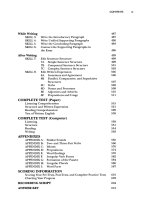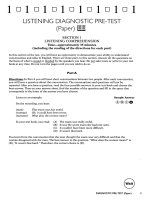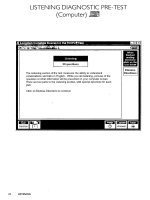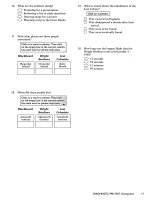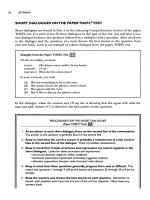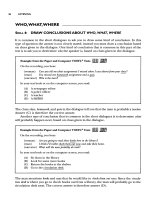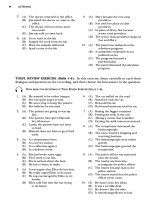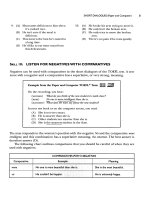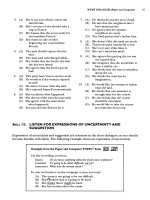Collins english for the toefl test reading writing
Bạn đang xem bản rút gọn của tài liệu. Xem và tải ngay bản đầy đủ của tài liệu tại đây (34.29 MB, 191 trang )
www.frenglish.ru
Be prepared
Collins
English for Exams
for all question types '
\
Learn
useful tips and strategies
Boost
your vocabulary
Increase
your fluency and accuracy
Build
your confidence
Improve
your score!
SKILLS FOR THE
TOEFL iBT TEST
Reading and Writing
www.frenglish.ru
Collins
English for Exams
SKILLS FOR THE
TOEFL iBT. TEST
Reading and Writing
www.frenglish.ru
Collins
HarperCollins Publishers
77-85 Fulham Palace Road
Hammersmith
London W6 8113
First edition 2012
Reprint 10 9 8 7 6 5 4 3 2 1 0
Reprinted 2013
HarperCollins Publishers 2012
ISBN 978-0-00-746059-5
Collins • is a registered trademark of HarperCollins Publishers Limited.
vnvw.collinselt.com
A catalogue record for this book is available from the British Library.
Editorial Services: ContentEd Publishing Solutions, LLC
Writing Services: Creative Content, LLC
Typeset in India by Aptara
Printed in Italy by Lego
All rights reserved. No part of this book may be reproduced, stored
in a retrieval system, or transmitted in any form or by any means,
electronic, mechanical, photocopying, recording or otherwise,
without the prior permission in writing of the Publisher. This book
is sold subject to the conditions that it shall not, by way of trade or
otherwise, be lent, re-sold, hired out or otherwise circulated without
the Publisher's prior consent in any form of binding or cover other
than that in which it is published and without a similar condition
including this condition being imposed on the subsequent purchaser.
HarperCollins does not warrant that www.collinselicom or any
other website mentioned in this title will be provided uninterrupted,
that any website will be error free, that defects will be corrected, or
that the website or the server that makes it available are free of viruses
or bugs. For full terms and conditions please refer to the site terms
provided on the website.
Academic Word List C Corhead, Avail (2000)
www.frenglish.ru
Contents
How to Use This Book
Overview of the TOEFL® Test
Guide to Reading
Overview
Challenges and Solutions
Detail Questions and Referent Questions
Lesson 1:
Lesson 1k Detail Question Overview
Walk Through
Get It Right: Tips and Tasks for Answering Correctly
Lesson 1B:
13
Referent Question Overview
Walk Through
Get It Right: Tips and Tasks for Answering Correctly
Progressive Practice
Lesson 2:
Lesson 2A:
Negative Fact Questions and Function Questions
Lesson 2B:
Function Question Ovenriew
Walk Through
Get It Right: Tips and Tasks for Answering Correctly
26
Negative Fact Question Overview
Walk Through
Get It Right: Tips and Tasks for Answering Correctly
Progressive Practice
Lesson 3:
Inference Questions and Vocabulary Questions
39
Lesson 3A: Inference Question Overview
Walk Through
Get It Right: Tips and Tasks for Answering Correctly
Lesson 3B: Vocabulary Question Overview
Walk Through
Get It Right: Tips and Tasks for Answering Correctly
Progressive Practice
Lesson 4:
Lesson 4A:
Lesson 4B:
Sentence Summary Questions and Passage
Summary Questions
Sentence Summary Question Overview
Walk Through
Get It Right: Tips and Tasks for Answering Correctly
52
Passage Summary Question Overview
Walk Through
Get It Right: lips and Tasks for Answering Correctly
Progressive Practice
iii
www.frenglish.ru
Lesson 5:
Lesson 5k
Add Text Questions and Table Completion Questions
Add Text Question Ovenfiew
Walk Through
Get It Right: Tips and Tasks for Answering Correctly
Table Completion Question Overview
Walk Through
Get It Right: Tips and Tasks for Answering Correctly
Lesson 5B:
65
Progressive Practice
Reading Review Test
82
Guide to Writing
Overview
95
Challenges and Solutions
Integrated Writing Task
Lesson 1:
Academic Reading / Lecture Synthesis Essay Overview
Walk Through
Get It Right: Tips and Tasks for Answering Correctly
107
Progressive Practice
Independent Writing Task
Lesson 2:
Personal Experience Essay Overview
Walk Through
Get It Right: Tips and Tasks for Answering Correctly
123
Progressive Practice
Writing Review Test
Answer Key
Audio Script
Academic Word List
iv
137
141
166
170
www.frenglish.ru
OE* OF THE TOEFL1FST
How to Use This Book
Skills for the TOEFL iffr Test: Reading and Writing, and its companion edition, Skills for the
TOEFL iBT• Test: Listening and Speaking offer a comprehensive guide to the TOEFL test If you
use this series to prepare for the test, you will earn a top score on the TOEFL test and improve
your chances at getting accepted by a great university.
No matter the level of your English, Skills for the TOEFL 1i3T Test: Reading and Writing provides
you with all the tools you need to succeed on the test. Here's a glimpse of the learning tools
included in this book
Skill-specific Challenges and Solutions sections. These sections offer strategy and skills
reviews to help you learn how to overcome the most common challenges in each section of
the test.
Quick Guide question overviews. Each lesson provides a brief summary of the question type
in an easy-to-read chart, making it simple for you to quickly understand what is important to
know to answer the question correctly.
Walk Through samples. Clear, visual examples show you the types of questions, passages, and
responses you can expect to find on the test. Knowing what to expect is an important part of
preparing for the test.
Get It Right presentations. These presentations give an overview of the most important steps
for doing well on each question. It provides Tips and Tasks for noticing and understanding
the important elements of each question type.
Progressive Practice. For each question type, carefully designed activities gradually prepare
you for the TOEFL test. This step-by-step practice builds the knowledge and skills you need
for a high score and encourages independent learning while working up to TOEFL testing
levels.
Get Ready activities require you to look and listen for certain pieces of information, practice
structured activities, and notice why answers are correct or incorrect
Get Set activities encourage even more practice working with the question types and
answers and will help you gain the skills and confidence you need.
Go for the TOEFL Test activities provide you with authentic test questions to practice what
you have learned and further prepare you for the test.
D
Answer Analysis presentations. The answer analyses will teach you how to eliminate
incorrect answer options and select the best answers for various question types.
Skill-specific Review Test sections. At the end of each section, you'll be able to put your skills
to the test by taking a practice test The review sections will help you identify your weaknesses
so you can know what areas to focus on before the test.
Test Tips. Throughout the book, you'll see Test Tips, which offer best practice strategies and
useful advice on how to approach certain activity types.
Dictionary definitions. Collins Gotland Advanced Dictionary definitions and web links are
provided throughout the book to help you understand words and build your knowledge of
academic vocabulary often found on the TOEFL test and in U.S. university texts and lectures.
Academic Word List, The Academic Word List, compiled by Coxhead (2000), consists of
570 word families that occur frequently over a wide range of academic texts. Knowing and
practicing these words will help you build your vocabulary base to understand and use more
academic English words.
www.frenglish.ru
TOER MT READING MID WRITING
a Audio Script and Answer Key Found at the back of this book, these tools will help you practice
and check your answers as you prepare for the TOEFL test. The Writing section also includes two
sample responses per question type.
a Audio CD. The CD included with this book provides you with all of the listening passages for
the Writing lessons and review test
Tips for Success
Make a plan to succeed, and start by following these tips:
Register for the test early. Check the application deadlines for the universities you are applying
to. Make sure that you register to take the test well before the deadline to ensure that your scores
arrive on time. For information on how to register, see page xi of this book. •
a Learn the score requirements for the universities you want to apply to. Degree programs that
have minimum score requirements typically post them on their admissions websites.
a Start to study early. The more you practice, the more you will improve your skills. Give yourself
at least one month to review the materials and complete all of the practice activities in this book
and in the companion edition: Skillsfar the TOEFL iBT Test: Listening and Speaking offer. Spend
at least one hour a day studying and don't give up. Remember, by using this book, you are on
your way to high scores on the TOEFL test!
a Time yourself when you complete the exercises and practice tests.
Complete the exercises on the page. Also, don't be afraid to make your own notes on the page.
For example, writing down the definitions to words you don't know on the page will help you
remember them later on.
On the reading sections, read the passages and the model responses as many times as you need to
in order to understand the concepts taught in this book
a On the writing section, return to the prompts and try to come up with new responses. Practice
until creating responses within the time limits becomes easy for you.
Overview of the TOEFL® Test
The TOEFL* iBT test (Test of English as a Foreign Language) measures your proficiency in English.
The TOEFL test does not evaluate your knowledge of the English language. Rather, it measures your
ability to use English in a variety of academic settings.
The test is divided into four timed parts: Reading, Listening, Speaking, and Writing. Each section
tests key skills that you will need in order to succeed as a student at an English-speaking university
Reading Section
The reading section is the first section on the test It measures your reading comprehension abilities
by presenting you with a series of academic passages. Then you will answer a set of questions based
on each reading. The questions in this section test your ability to:
D identify the main idea
a understand the main details
a make inferences
a understand the organizational structure of the passage
a use context dues to determine the definitions of key words
www.frenglish.ru
OVSMEW OHRE TOEFITEST
There are three to five academic reading passages per reading section. Each passage is between
600 and 750 words long. After each reading passage, you will answer a set of questions. There
are usually 12 to 14 questions per passage. In the reading section, you are allowed to go back to
previously-answered questions in the section to review or change your answers. For a detailed
discussion of the reading section, induding more information on the specific question types, see
pages 1-93.
TOEFL Reading
;)
••
"")0
v,
0
0
Question 1 of 12
1. Based on the information in paragraph
1, what can be inferred about Darwin's
theory of moon formation?
0 It was the first theory of moon formation
to gain wide acceptance.
0 It assumed that the Earth and moon were
made of the same material.
0 It was inspired by other scientists' work on
the condensation theory.
0 It explained why the Earth and the moon
developed at different times.
Paragraph 1 is marked with an arrow [4]
ere 00 .18 • 54
Origins of the Moon
Throughout the 19th and 20'h centuries,
several astronomers advanced competing
theories about how the moon formed.
For example, in 1878, astronomer George
Howard Darwin proposed fission theory,
which claimed that early in the Earth's
formation, the planet began spinning
extremely fast. Darwin believed that the
rapid spinning motion caused a large
chunk of Earth to break off and launch
into space. This chunk then began orbiting
the Earth and became the moon. Another
explanation, called the condensation
theory, stated that while the solar system
was still forming, a star exploded and left
behind mass amounts of debris. According
to condensation theory, the Earth and the
moon formed roughly at the same time,
and through the same processes, from this
debris.
Listening Section
The listening section is the second section on the test. In order to evaluate your listening
comprehension abilities, you will first listen to a lecture or conversation through your headphones.
Then you will answer a set of questions based on each listening. The questions in this section will
test your ability to:
identify the main idea or purpose of the listening
n understand the main details
make inferences
indentify the speaker's purpose
vii
www.frenglish.ru
TOEfL IBT READING NID WRMNG
There are six to nine listening passages per listening section. Each listening is between five to seven
minutes long. After each listening passage, you will answer a set of questions. 'There are usually five
to six questions per passage. In the listening section, you are mg allowed to review questions that
you have answered previously. For a detailed discussion of the listening section, including more
information on the specific question types, see Skills for the TOEFL MP Test: Listening and Speaking.
Speaking Section
The speaking section is the third section on the test. In this section, you will speak your response to
a variety of tasks into the microphone. The tasks test a number of speaking abilities, including:
)) giving opinions
understanding and responding to questions in the classroom
participating in discussions on academic subjects
synthesizing (combining) information from two sources
)) reporting the opinions of others
)) interacting with university employees
TOEFL Speaking
Question 1 of 6
Describe an activity that you like to do and explain why you
like doing it. Please include specific details in your explanation.
Preparation time: 15 seconds
Response time: 45 seconds
Preparation Time
00:00:13
viii
www.frenglish.ru
OVEFMEW OF METOEFLIEST
There are six speaking tasks in the speaking section: two independent tasks and four integrated
tasks. Each item requires different skills, including: speaking only; reading, listening and speaking;
and, listening and speaking. For more information about the speaking section, see Skills for the
TORE iBT Test: Listening and Speaking.
Writing Section
The writing section is the fourth section on the test. In this section, you will type your responses for
each item on the computer. The tasks measure your ability to:
9
plan and organize an essay
9
develop a written response by using examples or specific details
9 use a variety of grammatical structures and vocabulary
9 use correct spelling and punctuation
There are two writing tasks in the writing section: one integrated writing task and one independent
writing task. For more information about the writing section see pages 95-140.
TOEFL Writing
Directions: Read the question below. You have 30 minute to
prepare, write and revise your response. An effective response
usually contains at least 300 words.
Question,
Do you agree or disagree with the following statement?
It Is necessary to be competitive in order to succeed in life.
Use specific reasons and examples to support your response.
Experimental Sections
In order to field test new materials, ETS always includes an experimental section in either the
reading or listening section of each test. That means that on the day of the test, you will see extra
passages and questions in either the reading section or the listening section. If the experimental
section is part of the reading section, you will have to read an additional two passages and answer
the accompanying questions for them. If the experimental section is part of the listening section,
you will have to listen to an additional three listening (two lectures and one conversation) and
answer questions that are based on them.
Please note that the experimental section is not graded. However, you will have no way of knowing
which section is experimental, so it is very important that you try your best on all of the sections of
the tests.
ix
www.frenglish.ru
TOEFL IBT READING AND WRMNG
QUICK GUIDE: TOEFL® Test
Section
Reading
Section
Tasks
Timing
Reading Passages. 3-5
Part 1 (1 Passage + Questions)
Number of Questions:
Part 2 (2 Passages + Questions)
40 minutes
39-70
Part 3* (2 Passages + Questions)
40 minutes
20 minutes
Total Section Time: 60-100 minutes
Listening
Section
listening Passages: 6-9
Part 1(2 Lectures, 1 Conversation + Questions)
4-6 Lectures
30 minutes !
2-3 Conversations
Part 2 (2 Lectures, 1 Conversations+Questions)
Number of Questions:
30 minutes I
Part 3* (2 Lectures ,1 Conversations+Questions)
34-51
30 minutes
Total Section Time: 60-90 minutes
10 Minute Break
Speaking
Section
Number of Questions: 6
2 Independent
Total Section Time: 20 minutes
4 Integrated
Writing
Section
Number of Tasks: 2
1 Integrated
1 Independent
Integrated Task:
20 minutes 1
Independent Task:
30 minutes
Total Section Time: 50 minutes
"these parts are experimental and will appear on either the Reading or Listening Section.
Scoring
You will receive a score for each section of the test. The score ranges per section are as follows:
Reading
0-30
Listening
0-30
Speaking
0-30
Writing
0-30
In order to calculate your total score, the score for each section are added together. Thus, the
highest score you can possibly achieve on the TOEFL test is 120.
The reading and listening sections are both scored by computer. However, in order to determine
your scores for the speaking and writing sections, your responses are saved and sent to ETS, where
they are scored by certified raters. Each of the six responses in the speaking section are assigned a
score of 0-4. The scores for each task are added together and converted into a score on the 30-point
scale described above. Similarly, the two tasks on the writing section are given a score of 0-5. Again,
the scores for both tasks are added together and then converted to a score of 0 to 30.
www.frenglish.ru
PANSY OF DE TOB1.11EST
Score Reports
There are several ways to review your scores. First, you may view your scores online 15 business
days after the test All you have to do is visit the TOEFL website ( and sign
into the "My TOEFL iBT account" with the username and password that you created when you
registered for the test Your online score report will show the following information:
)) The date that you took the test
)) Your scores for each section
D Your total score
I> Performance evaluations for each section that describe whether your performance was low,
medium, or high
You may access your scores online for tests that you have taken within the past two years. Please
note that the universities and/or institutions that you have selected to receive your scores will also
be able to view your scores online.
In addition to being able to access your scores online, you will receive a paper score report via mail
two to three weeks after the test date.
TOEFL Test: What You'll See and Hear on the Day of the Test
Registration
There are a number of ways to register for the TOEFL iBT test.
Online Registration: Visit the TOEFL website at and follow the
instructions for registering. You will be able to find the nearest test center near you on the
website, as well as dates for upcoming tests. Seats at test centers are limited, so be sure to register
for the test early! You must register seven days before your desired test date. Late registration
is also available up to three days before your desired test date, but you will be charged a late
registration fee.
By Phone: Visit the TOEFL website and download the registration form. Then, call your regional
registration center (check website for phone numbers) and a representative will help you register.
Late registration by phone is available until 5 p.m. the day before your desired test date.
)) By Mail: Visit the TOEFL website and download, print and complete the registration form. Send
your completed form with payment to your regional registration center four weeks before the
desired test date.
For payment information and other details about the registration process, visit the TOEFL website
at />Before the Test Starts
When you arrive at the test center, you will sign in and give your identification document, such as
a passport, to a test center employee (for information about accepted identification documents,
see the ETS website at envw.ets.org). Make sure that the name on your identification document
matches the name under which you registered! If it does not match, you will not be allowed to take
the test.
After you sign in, the employee at the test center will instruct you to put your personal belongings
such as jackets, car keys, or cell phones into a storage area. Review the TOEFL website for rules
about personal items. You will also be given a document that outlines the rules of the test. At the
end of the document, you will see a statement of confidentiality. You are required to write this
xl
www.frenglish.ru
TOEFL IBT READING MID MMHG
statement at the bottom of the page. Then you will sign and date the document and submit it to the
employee.
Next, an employee at the test center will call your name. You will be asked to pose for a photograph
in order to ensure that you are the person who signed up to take the test (this photo will appear
on the paper copy of your score report). At this point, the employee will return your identification
document. The employee will also give you two pencils and several sheets of blank paper for notes.
You may be asked to show the employee the inside of your pockets to verify that you are not taking
any unauthorized materials into the test room. Then, an employee will escort you to the computer
on which you will be taking the test.
Screen-by-Screen Process
I. Confirmation of Identity: On the first screen, you will see your name and the photo that
you took before you entered the test room. Before you proceed, you must confirm that the
information is correct.
Copyright Screen: The next screen contains copyright information about the TOEFL test
materials. To proceed, click "Continue".
Test Introduction: You will see a screen that contains general information about the test,
including:
a general description of the TOEFL test
a short description of all four parts of the test
timing guidelines
Once you have finished reading the introduction, dick "Continue" to proceed to the next screen.
Test Rules: The next screen will describe the test policies. Be sure that you read the rules carefully
and that you understand them, as breaking any of the rules may result in cancellation of your
scores and you may lose your test fee. Click "Continue" when you've read and understood the
rules.
Confidentiality Statement: You will see a confidentiality agreement on the next screen. The
confidentiality agreement states that you will not share information about the test such as
passages or questions with anyone. Read the statement carefully. By clicking "Continue" on this
screen, you are agreeing to the terms of the confidentiality statement
Headset Instructions: On the following screen, you will be instructed to put on your headset.
The headset includes noise-cancelling headphones and a microphone. You are allowed to wear
the headset throughout the entire test.
ir,EF_
43-1
tfl
erl
sr. 00_11: 20
Please put your headset on at this time.
Make sure to properly position and adjust
your microphone in order to achieve a
high-quality recording. In your normal
speaking voice, speak directly into the
microphone.
zil
www.frenglish.ru
OVERYEN OF 111E TOIER TEST
7. Microphone Adjustment: Next, you will see a screen that gives you instructions on how to adjust
your microphone. You will be asked to speak a response to the following question: Describe the
city that you live in. Please note that this portion is not graded and is only used to adjust your
microphone. Just be sure to speak clearly and in your normal speaking voice.
You will continue to speak until a window appears that says "Success: Your microphone is functioning
properly" appears.
If your microphone adjustment is not successful, readjust the microphone so that it is closer to your
mouth and try again. If you continue having problems adjusting your microphone, raise your hand
to get help from an employee at the test center.
Section Screens
At the beginning of each section, you will see a screen that gives you directions about that
particular section. Please note that the on-screen tools will vary according to the section. For more
information about the screen-by-screen process for each section, see the Overviews and Walkthroughs for the questions types.
On-screen Tools
Throughout the test you will have access to a number of on-screen tools. The tools vary slightly by
section. For example, in the reading section, you will have a button that allows you to review your
answers. In the listening section, you will have buttons that allow you to confirm your answers
before you proceed. For more information about the specific on-screen tools, please see the
Overview for each section.
"Help" Button
During the reading and listening sections, you will see a "Help" Button on the toolbar at the top of
the screen. By clicking on the "Help" button, you will be given instructions for:
Using the on-screen tools
Marking your answers
Section directions, and
Test directions
Please note that when you access the "Help" materials, the clock will keep running. If you must
refer to the "Help" materials, be sure to do so quickly or you may waste precious time.
About the Break
After you've finished with the Listening Section, you are required to take a 10-minute break The
break screen will appear on the monitor. At this time, you may leave the test mom. You will have
to take your identification document with you. When you leave the test room, be sure to notify the
test center employee. You may be required to sign out during the break.
When you are ready to return to the test room, you will have show the test employee the contents
of your pockets once again. You may also have to sign back in. Then, the test center employee will
escort you back to your seat and unlock the screen so you can continue the test
Please note that while you are allowed to use the bathroom at any point during the test the dock
will not stop unless it is your designated break time. Therefore, to ensure that you have enough time
to finish each section, it is wise to only leave the test room during the break
www.frenglish.ru
TGEFL MT READING AND WRMNG
When You're Done
Score Reporting: After you've completed the final task of the writing section, you will see the
Score Reporting screen, which will re you the option of reporting or cancelling your scores. If
you choose to cancel the scores, you will not be able to see your scores. Furthermore, you will not
receive a refund of the test fee.
)
0 0 0 0
Ira- no 11 20
Report or Cancel Scores
At this time, please decide whether you would like to report or
cancel your scores from this testing session.
Checking Out: When you are finished, you may leave the test room. Be sure to bring your note
paper and pencils and personal identification document The test center employee will take back
the pencils and note paper. You will sign out and indicate the time that you finished the test Then
you can get your personal belongings from the storage area and leave the test center.
sly
www.frenglish.ru
Guide to Readin•
Overview of the Reading Section
The reading section is the first part of the TOEFL® test. It tests your comprehension
of written English by presenting you with a series of reading passages and then
asking you a set of questions based on each one.
QUICK GUIDE: TOEFL Test Reading Section
Definition
The reading section tests your ability to understand written academic English. The
section includes different types of reading passages that are based on a variety of
academic subjects.
Targeted
Skills
In order to do well on the reading section, you must be able to:
• understand basic academic vocabulary in context.
quickly scan a written passage and understand its main ideas and supporting
details.
understand how information is organized.
understand inferences, relationships, paraphrases and the purpose of a
passage.
answer questions within the given time.
The Reading The reading section includes three to five reading passages. Each passage
Passages
Is usually 650-700 words long. A typical reading section consists of three
reading passages, each of which will appear on your screen and remain there
while you answer the questions based on that passage. Please note that, on
some occasions, the testing company ETS will include two additional reading
passages as sample material. This sarnple material is not scored. However,
you will not know which passages are sample materials, so you should try your
best on all of the passages
There are three different types of passages in the reading section: expository,
argumentative, and historical. In addition, each passage is arranged according to
a particular organizational style, which include compare and contrast, cause and
effect, problem and solution, theory and support, and classification. For more
information about passage types and organizational Wes, see pages 1-80.
Questions
There are typically 12-14 questions per reading passage. The questions are
multiple choice and can usually be classified as one of the following question
types:
Detail
Referent
Negative Fact
Function
Inference
Timing
• Vocabulary
• Sentence Summary
• Passage Summary
• Add Text
• Table Completion
You will have 60 minutes to read and answer the questions for a set of three
reading passages. If you receive sample material for the reading section, which
will add an additional two reading passages, you will have 100 minutes to
read and answer the questions for all five reading passages.
1
www.frenglish.ru
SIOLLS FORME TOER IBT TEST READING AND WRMNG
Reading Section: What You'll See and Hear
On-screen Tools
In the reading section, the information on the computer screen is slightly different
than in other parts of the test. Study the sample screen below to familiarize yourself
with the on-screen tools for the reading section.
T, )FFL
hhir.
rt;
6-1 6
a
a• '
Question lot 12
Indicates what section of the test you
are currently working on
Shows which question you are currently
working on
Allows you to go back and view the
entire text for some questions
Takes you to a review saeen that shows
all of your answers for the section. By
clicking on any of the questions, you
can return to that question and change
your answer. This function also allows
you to view any questions you may have
skipped.
Allows you to adjust the volume of
the test narrator. When you click on
this button, you will be able to move a
slider up or down in order to increase or
decrease the volume.
Allows you to get important
information about the section. Keep
in mind that the clock will continue to
count down if you click on this button.
Used to return to previously answered
questions in the section
Used to move on to the next question
Allows you to hide or view the
countdown clock
Shows how mudi time is left in the
reading section
Screen-by-Screen ProcPcs
In the reading section, you will see a number of screens. By familiarizing yourself
with the screens and the instructions, you will know exactly what to do on the day
of the test.
Instructions: Fist, you will see a screen that gives you general information about the section, including
information about how the section is organized and how much time you will have to complete the entire
section. This screen also gives information about scoring and how to use the on-screen tools for the
section. You must wait until the narrator has finished reading the instructions before you are allowed to
move on to the next screen.
Reading: Once the section begins, a reading passage will appear on the right half of your screen. Note
that the entire passage will not be viewable on the screen—you will have to use the scroll bar to view
the rest of the passage. When you first see the passage, you should only scan it. In other words, you
should quickly read through the passage, paying special attention to the important ideas and details.
When you have finished scanning the passage, click on the "Continue" button.
2
www.frenglish.ru
OVERVIEW OE THE flEADING SECTION
TOEFL Reading
The Decline of the English Cloth Dade
After 45 years of the queen's rule, James!
succeeded Elizabeth Ito the English throne
in 1603, at which point the English economy
was struggling. The population of England
was swelling, food production was insufficient,
and prices were high. Despite its instability,
a few industries brought reliable income to
the English economy. In particular, many
merchants relied on the export of cloth to the
3. Questions: The questions for the passage will appear one at a time on the left side of the screen. Note
that the paragraph that the question is based on will be marked with an arrow (—)) in the passage.
To mark your answer, click on the cirde next to the answer option you want to choose. The circle will
turn dark when it has been selected. To deselect an answer, click on the circle again. After selecting
an answer option, click on the "Next" button to proceed to the next question. You may also click on the
"Back" button in order to view the previous question and change the answer.
TOEFL Reading
0 0 0 0
Question 1 0( 12
The word succeeded in paragraph 1 is closest in
meaning to
0 did away with.
came after.
0 turned aside.
0 kept back
Paragraph us marked with an arrow [4].
en on:18 54
The Decline of the English Cloth Trade
-*After 45 years of the queen's rule, James
I succeeded Elizabeth Ito the English
throne in 1603, at which point the English
economy was struggling. The population of
England was swelling, food production was
insufficient, and prices were high. Despite its
instability, a few industries brought reliable
income to the English economy. In particular,
many merchants relied on the export of cloth
4. End of Section / Confirmation Screen: When the given time for the reading section is over, you will see
a screen alerting you that the time is up. If you have viewed all of the questions in the reading section
before the given time is over, you will see a confirmation screen that informs you of your options. If you
want to continue working, you should dick on the "Retvm" button. If you want to see the review screen
in order to check your answers, click on the "Review" button. If you are finished and wish to proceed to
the next section, click on "Continue." Remember, if you choose to continue, you will not be able to return
to the section at aster time. Carefully consider whether you want to proceed or return to the questions
in the section.
3
www.frenglish.ru
SKILLS FOR THE TOEFL IP TEST READING AND MIRING
Review Screen
TOEFL Reading
TODEIMfm 00.11 20
Question 1 of 12
Below is a list of the questions from this section. The status column shows if you have answered the
question or not.
To review a question from this list, click on the question.
Passage
Questions
Status
The Decline of the English
Cloth Trade
I. The word succeeded in paragraph 1 is
closest in meaning to
Answered
The word its in paragraph 1 refers to
Answered
In paragraph 1, the author describes
insufficient food production as an
indication of the
Unanswered
Reading Seaton: Passage Types
In the reading section, you will be presented with reading passages that are similar
to texts that a student may encounter at a North American university. The topics for
the reading passages are drawn from a wide range of academic subjects, including
the following:
4
anthropology
• engineering
• music
archaeology
• environmental science
• paleontology
art history
• history
• photography
astronomy
• geology
• psychology
botany
• geography
• sociology
biology
• literature
• urban studies
education
• marketing
www.frenglish.ru
OVERVIEW OF THE READING SECTION
There are three types of passages on the reading section: expository,
argumentative, and historical. Typically, a reading section will consist of at least one
of each passage type.
Sample Topics
Passage Type Definition
Expository
Provides a general explanation of a
topic
Provides a point of view and gives
Argumentative several reasons to support that point
of view
Historical
Types of Camouflage
• Adaptations of Deep Sea Fish
• Important Traditions of the Bambara
Culture
Evidence of Contact Between Pacific
Cultures and Indigenous Americans
Recuperation Theory vs. Circadian Theory
of Sleep
How Non-Native Species Hurt Local
Habitats
History of the Telescope
The Effects of the Norman Conquest
Journalism and Social Change in the
Twentieth Century
Focuses on past events
Organizational Styles
Each passage will usually feature a specific organizational style. An organizational
style describes how the ideas in a passage are arranged.
Common Organizational Styles of Reading Passages
Organizational Style
Description
Classification
Describes two or three different categories of something
Compare / Contrast
Discusses similarities and differences between two or more
things
Cause / Effect
Explains the causes and effects of something
Theory / Support
Presents a theory and provides support for it
Problem / Solution
Presents a problem and discusses solutions
5
www.frenglish.ru
SKILLS FOR THE TOEFL IBT TEST READING AND WRITING
Challenges and Solutions
II CHALLENGE 1: "I don't know a lot of the words that I see in the passages or In the questions."
SOLUTION: Expand your vocabulary. There are several tools that you can use to increase your
vocabulary. For one, there are several word lists available that present the most common words found in
academic settings. The Academic Word List, developed by Averil Coxhead, is a list of 570 words that are
commonly included in introductory college texts. Getting to know these words will likely help you perform
better on the test and prepare you for entering English-language courses. For more information on the
Academic Word List, see page 170.
SOLUTION: Use a learner's dictionary when you study. Dictionaries such as the Collins Cobuild
Advanced Dictionary offer clear definitions, sample sentences, grammar, illustrations, and photographs
to help you expand your knowledge and use of everyday and academic vocabulary. In this book, you will
find definitions for challenging or unfamiliar words, much like you would in the TOEFL reading passages.
These definitions come from the Collins Cobuild Advanced Dictionary.
SOLUTION: Use context clues. Context clues are the words and phrases that surround key words. Using
these clues will help you determine the meanings of unfamiliar words. The author may use a number of
strategies to provide context clues for key words, including giving examples of the keyword, contrasting
the meaning of the key word with an opposite idea, or giving an indirect definition of a key word. For
more information about these strategies, see the table in Lesson 3B on page 44. To practice finding
and using context clues, try reading a 300-word excerpt from a newspaper or a college textbook. Pay
attention to the strategies that the authors use to help you figure out the definitions of difficult words.
Strategies for Using Context Clues
Strategy
Key Words
Example
Pay attention to examples that appear near the
such as
including
consists of this
includes like
The photographs show
banal activities, like goi
to thegrooerv store or
doing household chores.
highlighted word. If you are familiar with the
examples, you can use them to determine the
meaning of the highlighted word.
Unlike X...
Look for key words that signal a contrast from a
On the other
previous idea. If you know the meanings of the
hand, X...
words from surrounding sentences, you'll know
that the highlighted word has an opposite meaning. But...
However ...
Look for indirect definitions of terms in the
sentences that surround the highlighted word.
These definitions may indude an easier synonym
of the highlighted word or information that helps
darify its meaning.
and
meaning that
Unlike most mammals, few
of which are venomous
the platypus produces a
noxious substance that
can cause extreme pain in
humans.
In the southwestern United
States, the sunflower is
ubiquitous grid it is
difficult to find a garden
that doesn't include the
SOLUTION: Learn how to look at word parts, like prefixes and suffixes, to determine the meanings of
unknown words. Many English words are formed through the use of prefixes, which go at the beginnings
of words, and suffixes, which go on the ends of words. By learning the meanings of common English
prefixes and suffixes, you will be able to guess the definitions of unknown words. For more information,
see the table in Lesson 3B on page 45.
6
www.frenglish.ru
OVERVIEW OF THE READING SECION
b CHALLENGE 2: "I often run out of time before completing allot the questions."
SOLUTION: Use skimming and scanning skills to find the answers to the questions. Skimming is when
you quickly read a passage, paying attention only to the most Important Ideas. By skimming, you can
often identify the key ideas that many questions are based on in a short amount of time. This way, you
can avoid running out of time during the test.
In order to skim effectively, make sure you know where to find the most Important Ideas. Regardless of
the different organizational styles for passages, important ideas often appear in the same places. See the
table below for information on where to find a passage's most important ideas.
Part of the Passage
Skimming Strategy
Introduction
• Read the last two-three lines in the introductory
paragraph. These lines will typically describe the main
idea of the passage.
Body Paragraphs
• Read the first two-three lines in the body paragraphs.
These sentences will describe the main ideas of the
paragraphs.
Read the last two-three lines in the body paragraphs.
These lines will often explain how each paragraph
relates to the main idea of the passage. These lines will
also help you understand how the body paragraphs are
related to one another.
Scanning is when you read the passage quickly in order to find specific key words or ideas. After you've
read a question and its answer options, you should make note of any key words or ideas, like names,
terms, or numbers, that will help you answer the question. Then, scan the passage, looking specifically
for those key words.
Remember, you don't need to understand every word perfectly while you skim or scan a passage. The most
important part is to find the information you need in order to answer the questions quickly and correctly.
To practice skimming and scanning, find an article with 600-700 words in a college textbook. First,
skim the article and 'mite down the most important ideas on a piece of scrap paper. Then, try scanning
the article for key words and dates. The more you practice skimming and scanning, the faster and more
accurate you will get, so try to practice every day.
SOLUTION: Pay attention to the on-screen clock. This clock displays how much time you have left
in the section. You should not spend more than 20 minutes on each reading passage. While you work
on the questions, be sure to glance at the clock. On the reading section, you are able to return to
unanswered questions later, so be sure to take advantage of this feature. If you take more than two
minutes on a question, skip it and return to it later. This will help you avoid getting stuck on one question
and wasting your time.
7
www.frenglish.ru
&IOUSFOR THE TOEFL IBT TEST READING AND WRITING
CHALLENGE 3: "The passages are often complicated and confusing—sometimes I get lost as
I'm reading them."
SOLUTION: Understand the basic organizational styles found on the reading section of the TOEFL test.
If you lose concentration or become confused while you are reading, you just have to Think about how the
passage is structured in order to get hack on track. See the table below for the most common organizational
structures of the reading passages and how the information in these passages is often arranged.
0
Classification
Compare /
Contrast
Problem /
Cause / Effect Solution
Theory /
Support
Introduces what
will be classified
in the passage
Introduces two
ideas, things, or
events
Introduces
an event or
process
Introduces a
problem
Introduces a
theory
Present 2-3
different types
or features of
the subject being
classified
The first body
paragraph
describes several
features of the
first subject. In
the following
paragraphs, the
author presents
corresponding
features of the
second subject,
pointing out how
these are similar
to or different
from those of the
first subject.
The first body
paragraph
describes 1-2
causes for
an event or
process. Then,
the author
describes the
effects, or
consequences,
of the causes.
Provide 2-3
solutions to the
problem
Provide 2-3
pieces of
evidence to
support the
theory
To practice, read each of the passages in this book. See if you can identify the organizational structure of
each passage. Make note of how the body paragraphs are organized.
SOLUTION: Look for transition language as you read. Transition language includes words and phrases
that are used to connect the ideas in different sentences. For example, some transition words signal
the introduction of a new topic (e.g., "Mother example of X is ..."), while others signal a process or
sequence of events (e.g., "First ..."). Transition words often appear at the beginning of a new paragraph,
though they can appear in the middle part of a paragraph as well. By paying attention to transition words
and how they are used, you can get a better sense of what is happening in the passage. In turn, this will
help you avoid becoming confused by the information in the passage. For a more detailed discussion on
transition words and to practice identifying them, see page 67.
8
www.frenglish.ru
OVEFME• OF THE READING SEC11ON
CHALLENGE 4: "There's too much Infomiation to remember!"
Solution: Don't worry about remembering every detail from the passage. In the reading section, the
passages will always appear on the right side of the screen while you answer the questions. The
paragraph that the question is based on will be marked with an arrow [4], and you will be able to scroll
through the paragraph as you answer the question in order to find any information you may need.
SOLUTION: On your scrap paper, create a quick outline of the passage. Just because you have access
to the passage while you answer the questions doesn't mean that it's not helpful to write down notes in
certain instances. For example, while you skim the passage, you can create a quick outline of the basic
points in the reading. You should try to use abbreviation strategies so you don't spend too much time
writing your outline. Then, you can use this outline as a quick reference while you answer the questions.
The outline does not need to contain all of the details from the passage, but it should contain the main
ideas, which can be helpful when answering nearly all of the question types. See below for a sample
outline for a reading passage. This outline is based on the passage on page 23.
Age of Bradshows: unsure, wasp nest
2 theories about who created Bradshaws
- Australian Aborigines
similar to Aboriginal artwork
- 1st humans in Aust.
human migration studies
canoes, animals in paintings
Note that while the outline is very brief, it still contains the most important ideas from the passage.
Furthermore, the outline reflects the basic organization of the passage, which would be especially helpful
for table completion or passage summary questions. Regardless of what question type you are working
on, by writing this information down, you may find that you understand the basic ideas of the passage
better and remember them more clearly.
SOLUTION: Write down key words and ideas as you read the questions and answer options. Some
people find it helpful to highlight key words while they read. However, on the day of the test, you will gf
be able to highlight any portion of the text on the computer screen. Instead, you can use your notepaper
to write down any key words that will help you remember important ideas from the questions or the
answer options. Then, you can refer to your list of key words and quickly scan for them in the reading
passage.
9
www.frenglish.ru
SIOLLS FOR THE TD. IBT TEST READING AND WRITING
s CHALLENGE 5: "I have a hard time telling the difference between major supporting details and
minor facts."
SOLUTION: Try to understand the role of the details in the passage. By understanding how the details
that you are confused about relate to the ideas in the passage, you will be able to sort the major details
from the minor ideas. Use the steps in the table below to start understanding the roles of details in a
passage.
Steps For Differentiating Between Major Supporting Details and Minor Facts
Skim the first paragraph to find the topic sentence. Topic sentences are sentences that express
the main topic of a passage or paragraph. Regardless of the passage type or organizational style
of a passage, each reading will have a major point that it is trying to make.
The introduction will usually provide a brief background of the main topic and then present a
topic sentence that summarizes the main point of the passage.
ri
Skim the body paragraphs to find the topic sentence for each paragraph. The topic sentences
are usually located within the first two or three lines of the body paragraphs.
By locating the topic sentences, you can start to understand what the main argument of the
passage is and how the author has organized the flow of ideas.
Once you've located the topic sentences and the main point of the passage is clear to you,
s
ai quickly review the details that you are unsure about Again, when you review details, make
sure you scan the passage for the key words associated with those details in order to save time.
When you read a sentence containing a detail you are unsure about, ask yourself the following
question: If you were to leave out that particular detail, would the main point of the passage be
sr weakened?
If the answer is yes, the detail in question is probably a major detail. On the other hand, if
leaving out the detail would not majorly change or weaken the main point of the passage, then
the detail is a minor fact.
10

